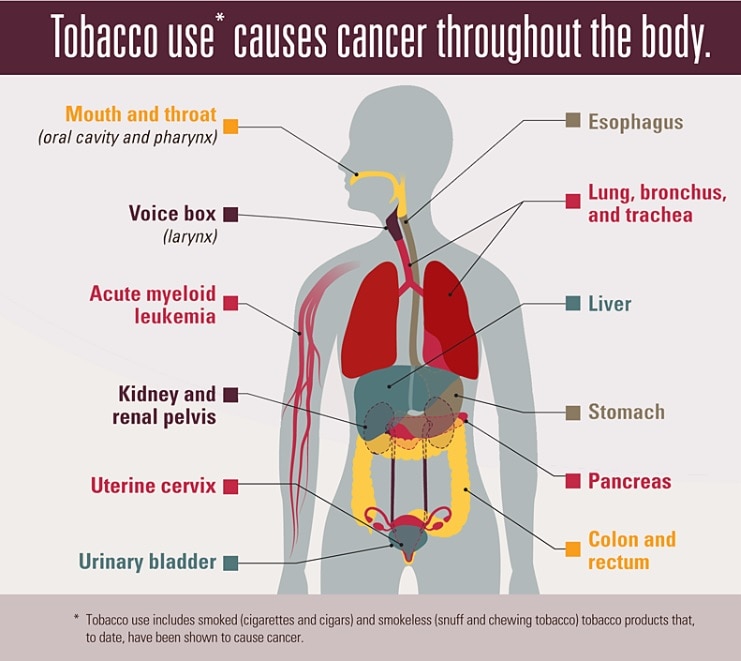From the CDC

If you were asked to describe the relationship between “tobacco smoking” and “cancer,” you might immediately think of lung cancer. It’s true that smoking tobacco products (including cigarettes and cigars) causes almost nine of every 10 cases of lung cancer, but smoking can cause cancer almost anywhere in your body, including in the—
- Bladder.
- Blood (acute myeloid leukemia).
- Cervix.
- Colon and rectum.
- Esophagus.
- Kidney and renal pelvis.
- Liver.
- Lungs, bronchi, and trachea.
- Mouth and throat.
- Pancreas.
- Stomach.
- Voice box (larynx).
Health Advice for People Who Use Tobacco or Are Thinking of Using Tobacco
The most important things you can do to avoid health risks from cancer are—
- If you don’t smoke or use tobacco—don’t start!
- If you do smoke or use tobacco—quit!
No matter how long you have smoked, quitting can reduce your risk for cancer and other chronic diseases. Quitting smoking can be hard. Most smokers try to quit many times before they succeed. For more information about quitting smoking, go to smokefree.gov.external icon
How Tobacco Products Cause Cancer
Tobacco smoke has at least 70 chemicals that cause cancer, also known as carcinogens. Every time you breathe in that smoke, those chemicals get into your bloodstream, which carries the chemicals to all parts of your body. Many of these chemicals can damage your DNA, which controls how your body makes new cells and directs each kind of cell to do what it is made for. Damaged DNA can make cells grow differently from how they are supposed to. These unusual cells can turn into cancer.
Secondhand Smoke
Smokers are not the only people who can get cancer from tobacco smoke. People around them—their kids, partners, friends, coworkers, and others—breathe in that smoke, too, called secondhand smoke.
Other Tobacco Products
Smokeless tobacco products, such as dipping and chewing tobacco, can cause cancer, too, including cancers of the esophagus, mouth and throat, and pancreas. Smoking cigars causes lung cancer and increases the risk of cancers of the mouth, throat, larynx, and esophagus.
Electronic cigarettes produce an aerosol by heating a liquid that usually contains nicotine—the addictive drug in regular cigarettes, cigars, and other tobacco products—flavorings, and other chemicals that help to make the aerosol. Users inhale this aerosol into their lungs. Bystanders can also breathe in this aerosol when the user exhales into the air. E-cigarettes are not safe for youth, young adults, pregnant women, or adults who do not currently use tobacco products.
Health Disparities
Differences between groups of people in their level of health, quality of health care, how many have a particular health problem, and so on, are called health disparities. The groups of people might differ by age, race, income, rural residence, or some other characteristic. People who are poorer, less educated, or part of certain racial or ethnic groups are more likely to smoke.
